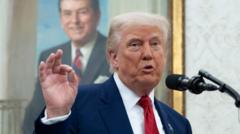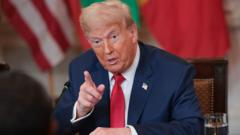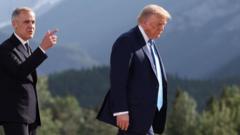This ruling, which blocks sweeping import taxes, could lead to significant changes in international trade relations and domestic economic impacts.
**US Court Overturns Trump's Tariffs: What Lies Ahead?**

**US Court Overturns Trump's Tariffs: What Lies Ahead?**
The Court of International Trade's decision against Trump's tariffs raises questions about the future of U.S. trade policy.
The U.S. Court of International Trade has delivered a significant setback to former President Donald Trump's trade policy by blocking his sweeping tariffs, a cornerstone of his economic approach. The court ruled that Trump's invocation of an emergency law did not grant him the unilateral authority to impose tariffs on nearly all trading partners, emphasizing that such powers reside solely with Congress under the Constitution.
The ruling stems from a lawsuit filed by the Liberty Justice Center, representing five small businesses affected by the tariffs. The court’s decision specifically targeted the International Emergency Economic Powers Act (IEEPA) of 1977, which Trump cited as justification. The court also took action against various tariffs imposed on China, Mexico, and Canada that the Trump administration had enforced in response to perceived national threats, although it did not address tariffs on specific goods like steel and aluminum.
While the White House criticized the ruling, claiming judges should not dictate national emergency responses, many saw the decision as a triumph for states like New York—whose Attorney General Letitia James stated that no president should have the capacity to unilaterally raise taxes. The verdict has also positively influenced global markets, with Asian stocks climbing and gains in the U.S. dollar against safer currencies.
Now, the White House faces a 10-day window to halt the tariffs. Should the administration appeal and fail, businesses which paid these tariffs could receive refunds plus interest. Investors have expressed relief at the ruling, signaling a potential shift back towards economic stability and regulatory guardrails, rejecting a precedent of executive overreach in trade matters.
The contentious tariffs were initially introduced by Trump in early April with a blanket 10% tax on most countries, aiming to uplift American manufacturing. They triggered a turbulent trade environment, particularly with China, as both nations engaged in an escalating cycle of retaliatory tariffs. Following negotiations, these duties have seen modifications, yet the recent court ruling offers a pivotal moment in the ongoing trade narrative, shifting the focus from executive authority to legislative boundaries in trade law.
The ruling stems from a lawsuit filed by the Liberty Justice Center, representing five small businesses affected by the tariffs. The court’s decision specifically targeted the International Emergency Economic Powers Act (IEEPA) of 1977, which Trump cited as justification. The court also took action against various tariffs imposed on China, Mexico, and Canada that the Trump administration had enforced in response to perceived national threats, although it did not address tariffs on specific goods like steel and aluminum.
While the White House criticized the ruling, claiming judges should not dictate national emergency responses, many saw the decision as a triumph for states like New York—whose Attorney General Letitia James stated that no president should have the capacity to unilaterally raise taxes. The verdict has also positively influenced global markets, with Asian stocks climbing and gains in the U.S. dollar against safer currencies.
Now, the White House faces a 10-day window to halt the tariffs. Should the administration appeal and fail, businesses which paid these tariffs could receive refunds plus interest. Investors have expressed relief at the ruling, signaling a potential shift back towards economic stability and regulatory guardrails, rejecting a precedent of executive overreach in trade matters.
The contentious tariffs were initially introduced by Trump in early April with a blanket 10% tax on most countries, aiming to uplift American manufacturing. They triggered a turbulent trade environment, particularly with China, as both nations engaged in an escalating cycle of retaliatory tariffs. Following negotiations, these duties have seen modifications, yet the recent court ruling offers a pivotal moment in the ongoing trade narrative, shifting the focus from executive authority to legislative boundaries in trade law.



















